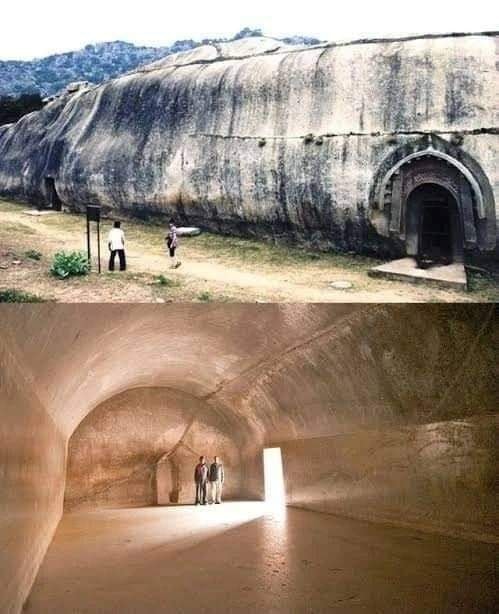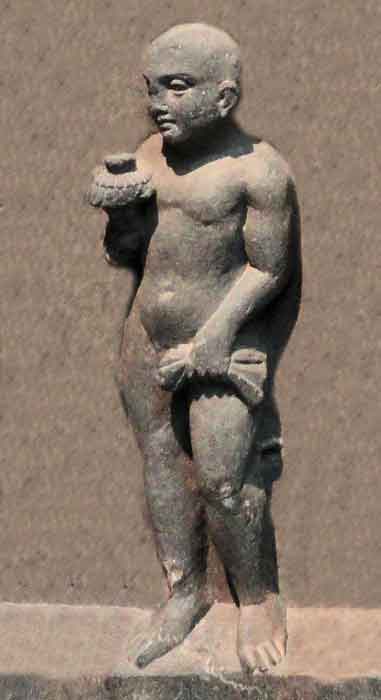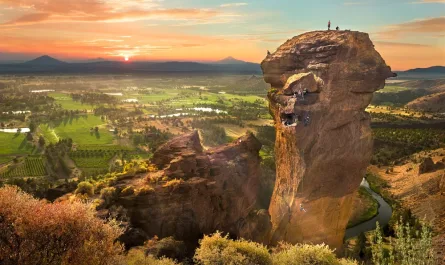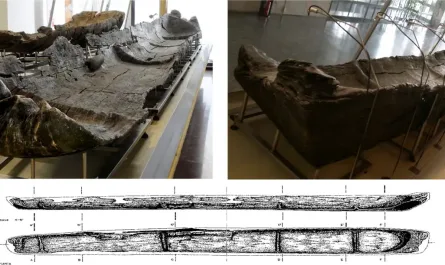
The Barabar Caves are a group of rock-cut caves located in the eastern Indian state of Bihar. The Barabar Caves contain a total of seven caves, the oldest of which date to the Mauryan period. The caves from the Mauryan period are reckoned to be the oldest rock-cut caves in India. The Barabar Caves are known primarily for their inscriptions, some of which have been dated to the reign of Mauryan emperor Ashoka. The caves are also notable for their architecture.

The Barabar Caves are located in the Jehanabad district in Bihar, in the eastern part of India, and consist of seven rock-cut caves. Four of the caves are situated on the hill of Barabar (the Karan Chaupar, Lomas Rishi, Sudama, and Visvakarma caves), whilst the other three are on the nearby hill of Nagarjuni. Sometimes, the caves on Nagarjuni are considered as a separate group of caves.
The caves were carved out of the solid granite bedrock, most of them containing two chambers. Generally speaking, the first chamber would have been used to accommodate large groups of devotees, whereas the second one contained a stupa, a mound-like structure containing relics. Due to the highly polished surface of the caves’ interior, the so-called “Mauryan polish,” the chambers have a unique echo effect. One can imagine the effect this would have had on the worshippers assembled in the caves.

The famous carved entrance of the Lomas Rishi Cave, one of the Barabar Caves in Bihar, India, featuring the oldest chaitya arch in India. (Dharma / CC BY 2.0)
The famous carved entrance of the Lomas Rishi Cave, one of the Barabar Caves in Bihar, India, featuring the oldest chaitya arch in India. (Dharma / CC BY 2.0)
The Barabar Caves: Buddhism, Emperor Ashoka, and Ajivika
The Barabar Caves lie about 31 km (19.3 mi.) to the north of Bodh Gaya, a pilgrimage site sacred to Buddhists, as it is believed to be the site where the Buddha attained enlightenment. Due to the association of the Barabar Caves with the Mauryan emperor Ashoka, one would assume that they too have some connection with Buddhism. This is visible in the Lomas Rishi Cave, the most famous of the seven caves.
Ashoka the Great: From Cruel King to Benevolent Buddhist
The Rise of Chandragupta Maurya, and the Golden Age of the Mauryan Empire
Despite its lack of Ashokan inscriptions, the Lomas Rishi Cave is believed to have been occupied by Buddhists. This lack of inscriptions, incidentally, is due to the cave being incomplete. It is speculated that the cave’s structural problems meant that the work was not completed, or that the cave was actually built towards the end of the Mauryan Empire, and the work was stopped following the murder of the last Mauryan emperor. Consequently, the association of this cave with Buddhism was based on something else, i.e., its architecture. It has been argued that the cave resembles the wooden huts that Buddhist monks and ascetics lived in, hence its association with Buddhism
Apart from that, another notable architectural feature of the Lomas Rishi Cave is its chaitya arch (or gavaksha), which is used on the entrance door. The chaitya arch at the Lomas Rishi Cave is thought to be the oldest of its kind that has survived till today, and subsequent developments in this unique architectural feature have all been traced back to the Lomas Rishi Cave arch.
The Pskov-Caves Monastery and its 10,000 Monk Necropolis
Unity in Diversity: Studies Reveal Surprising Stories for the Genes of Ancient Hindus and Jews
The occupation of the Lomas Rishi Cave by Buddhists, however, seems to be the exception, rather than the rule. This is because the other caves were dedicated to a now-forgotten Indian school of thought called Ajivika. This is shown by the Ashokan inscriptions that have been found at the site. The Ashokan inscription in the Sudama Cave, for instance, records that the cave was given by the emperor to the Ajivika monks in 261 BC. It seems that the Mauryan rulers continued to patronize the Ajivikas even after Ashoka’s death. An inscription in one of the caves on Nagarjuni hill, for example, dates to the reign of Dasaratha Maurya, the grandson of Ashoka, and relates to the Ajivikas.

An Ajivika ascetic in a Gandhara sculpture of the Mahaparinirvana, circa 2nd-3rd century AD. With the exception of one cave, the Barabar Caves are connected with Ajivika spiritual practices. (Daderot / CC0)
During the Mauryan Empire, Ajivika Was A Major Sect
Ajivika is mostly forgotten today, but during the time of the Mauryan Empire, it was a major school of thought. In fact, they were influential enough to compete with Buddhism and Jainism. Like their rivals, the Ajivikas were considered as a nastika, or “heterodox” (holding unorthodox opinions or following unorthodox doctrines) Indian school of philosophy. Additionally, the founder of this school, Makkhali Gosala, is said to have been a contemporary of Gautama Buddha, the founder of Buddhism, and was once a companion of Mahavira, the 24th Tirthankara of Jainism.
Under the Mauryans, and their predecessors, the Nandas, the Ajivikas flourished. Subsequently, however, they declined rapidly, and disappeared altogether. The cause of the school’s demise is unclear. Unfortunately, the texts of the Ajivikas are not known to have survived, and the information we have about them today comes from Buddhist and Jain sources. Needless to say, they do not paint a very positive picture of their rival. With regards to the Barabar Caves, once the Ajivikas were gone, they were reused by Buddhist, Jains, and Hindus.
Mahavira: Abandoning Luxury to Revive Jainism
Modern Hindus Forbidden From Eating Beef But Ancient Hindus Ate the Sacred Cow
Today, the Barabar Caves are a tourist destination, and is especially popular as a side trip for those visiting nearby Gaya. Unfortunately (or perhaps fortunately), tourist facilities at the site have not been developed much. On one website, for instance, it is stated that the site has neither accommodations, nor places where tourists can get food and drink.
Top image: Two entrances to the Barabar Caves: Sudama Cave (small entrance, left side), and Lomas Rishi Cave on Barabar Hill. Source: Klaus-Norbert / CC BY 3.0
By Wu Mingren





